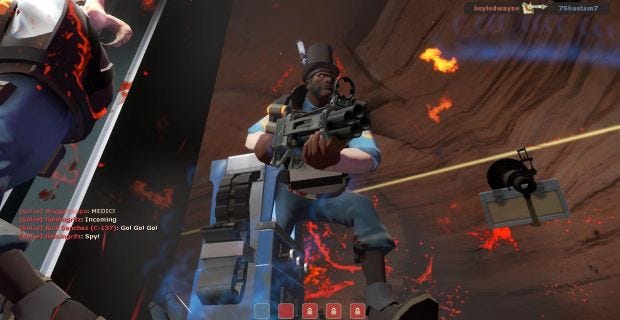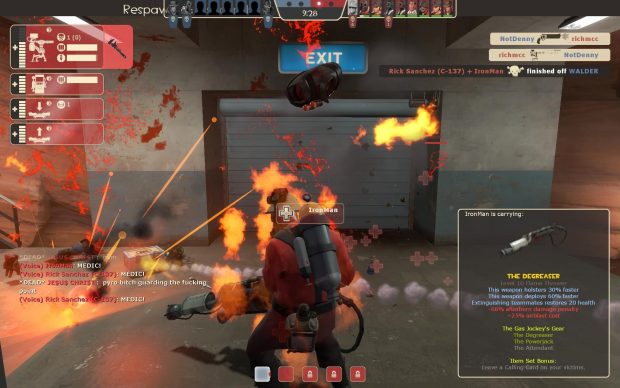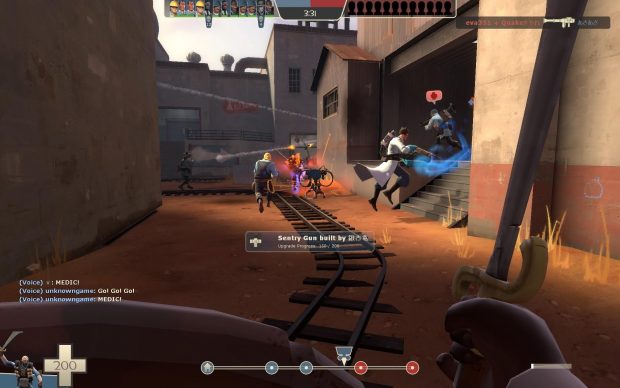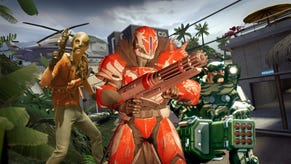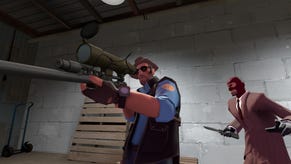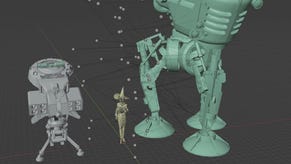Has Team Fortress 2 been improved by its updates?
Update Night
Update Night is a fortnightly column in which Rich McCormick revisits games to find out whether they've been changed for better or worse.
This is RPS, so let's get literary. Team Fortress 2 is the game version of the Picture of Dorian Gray — but in reverse.
Back in 2007, Valve put its near-perfect multiplayer creation on both console and PC. The two versions of Team Fortress 2 started out the same, with the same nine cartoonish classes, weapons, and maps, but ended up with very different lives. On console, TF2 never saw the sun. It was shut away on Xbox Live and PSN, ignored in updates and shunned by players. On PC, however, it made a deal to live a life of liberty, to go out into the world and grow. The game sprouted a community and became popular, spawning update after update after update.
Like the unaging Gray, the blemish-free vanilla version continued to exist, trapped in amber on PlayStation 3s and Xbox 360s that have — like the story’s titular picture — now been hidden away in attics. It's still there, if you know where to find it, but nobody bothers to. Meanwhile, the gnarled, twisted, changed version walks the internet, scaring past friends with his vastly different visage and new free-to-play form.
Except, you know, where Dorian Gray had a manky rotten skull face, Team Fortress 2 has new weapons, crates, keys, modes, and — of course — hats. Valve added hats upon hats upon hats (literally, in some cases), over the past decade, until the original game feels like a distant memory. Valve’s most recent updates have pulled the game even further into the modern day, introducing matchmaking in both competitive and casual flavours. Competitive matchmaking is locked behind a paywall — remember that this is now a free-to-play game — but casual matchmaking generally makes getting into a match easy and reliable. That’s not always the case, though. TF2 now straddles the gap between the olden days anything-goes of an early-2000s server browser and the slicker, smoother, far-less-customisable experience commonplace in modern shooters. One in 10 of the servers I joined would strip my weapons and enforce hand-to-hand combat, or offer me a suite of game-breaking power-ups, or pass me a grapple gun and let me shoot around the stage like Spider-Man.
These weren’t always negative experiences, and sometimes brought back fond memories of wacky Counter-Strike servers running de_rats or gameshow mutators. But it got annoying on the fourth or fifth attempt, when all I wanted to do was try one of TF2’s new community-created maps using the weapons I was meant to be using. Fortunately, the server browser’s still there in the game, tucked away under matchmaking options for when you find a preferred server home and never want to let it go.
For a lot of players who dropped off TF2 after its 2011 peak, the biggest change will be the number of new weapons for each class. The result of this hefty collection is that TF2 can feel closer to Dota 2 — its apparent usurper in Valve’s affections — in that new and returning players need to learn the form and function of hundreds of items. This opens the door to boundless creativity in item builds, but can also feel frustrating, especially when you’re killed by guns you’ve never seen before. I was menaced by Soldiers and Spies, in particular, skill classes controlled by skilled players who’d stuck with the game for a decade. One devastatingly competent Spy sowed total chaos during one of my games, lining up my entire team and chomping straight through them, using the Your Eternal Reward knife to instantly disguise as his latest victim. Conceptually, I know how best to stop a Spy, but in the midst of a 12-on-12 firefight, this specific bastard reigned supreme.
The kind of chaos the Spy thrives in has been dialed up for nu-TF2. Vanilla Team Fortress 2 was founded on concepts of silhouettes and ease of recognition: players could immediately identify what was coming for them, and how best to counterbalance it. Add in hundreds of guns, items, and hats, and those silhouettes have been well and truly blurred, making it trickier to know the right play in the right situation.
There are still only nine characters, but there aren’t just nine classes any more. The Pyro started as an ambusher, but I outfitted my muffled killer as a protector, giving him the Homewrecker hammer to knock Spy sappers off teammates' buildings, and the Manmelter pistol to put out flaming friends. The Demoman can be a defensive powerhouse or an offensive line-wrecker, depending on whether you give him sticky bombs or a super-sized sword. The Spy has become even more intricate, an array of watches, revolvers, and knives allowing players to become careful planners or panicked stabbers. The Heavy is still a markedly heavy man, but items both old and new let him decouple from his Medic partner and work as anything from snapshot semi-sniper to suppressing fire spray-and-prayer.
That’s true in casual matchmaking, anyway, where most of my opponents seemed to use a wide range of reskinned, renamed, or otherwise fancified weapons just because they had them in their inventory. On the competitive side of the fence, however, on both servers and Twitch streams, players are more likely to default into specific builds. Stepping outside of these builds can lead to punishment, either in game terms as you’re stomped by organised crews running the right builds, or derided by your teammates for using such a stupid loadout.
Valve has made attempts to curb this behaviour and keep all weapons viable. The developer’s latest update includes nerfs to items like the Sniper’s crocodile-skin shield, which had become a de facto selection for its health boosts to the class, and tweaks to the Soldier’s BASE Jumper parachute to stop players having too easy a time raining rockets from above. But the pressure to know and conform to this metagame kept me leaning back toward the casual matchmaking lists, where I could observe and understand how some of the newest weapons worked.
This, I should note, comes from the perspective of someone who played TF2 from launch. 10 years is a long time for Valve to build up an impressive catalogue of weaponry, but if you’ve dug back into the game more recently, you may be more disappointed with its newest features. The most recent meaningful addition to the classes’ arsenal came in 2014, with the introduction of the Panic Attack shotgun and two new variants to the Demoman’s grenade and sticky bomb launcher.
The three years since have instead been filled with a barrage of cosmetic items, in the form of taunts, reskinned variants of existing weapons, and of course, hats. Those weapon skins were introduced a few months after the game went free-to-play in 2015, alongside a Campaign system that players could pay for entry to, and earn rare items through. Campaigns added a layer of direction to TF2’s unstructured team combat, but have been deployed sparsely, leaving months between their activation. Valve has recently promised a more open development process in the future, but compare the situation to that of TF2’s main competitor — Overwatch — and the older shooter suddenly feels a little neglected.
Fortunately, TF2 can still lean on its community to breathe some new life into its decade-old form. New maps enter the rotation reasonably often, and their creators are supported by purchases of stamps, sold on the official TF2 store. The free-to-play aspects of the game don’t typically feel too egregious, either. Weapons still drop in game, and I found a number of duplicates during my hours of play, but players can opt to bypass the whims of the drop lords and just buy every class weapon outright with real money. These can be bought in cheapo bundles, ranging from £1.52 for all of the Medic’s functionally different tools, to £4.59 for every one of the Soldier’s guns and items. I splurged on the Sniper’s full pack, getting my hands on the gun that splashed enemies with piss in the process, and was happy with the price of entry.
The same can’t be said for the crafting system, which requires ludicrous investment before paying out in sweet, sweet hats. Even when I unsentimentally culled the majority of my backpack items, smelting down toys I had earned — and cherished — as a younger man, I still found myself several chunks of scrap metal short of a hat. A single hat. It’s much easier just to go and buy a new one from the shop for a few quid: a decision that feels forced by restrictive crafting mechanics and a slow drop rate.
I'm a sucker, though, so I ended up doing just that. A few hours after I returned to TF2, I treated myself to a Demoman helmet, all the while thinking how weird it was that the game that helped define the present-day cosmetics economy of free-to-play shooters felt a little unfair.
But it's what's underneath the hat that matters. And, like Dorian Gray's gribbly face, although TF2's skin has changed, the bone structure remains largely the same. New items can make the classes incredibly situational in their use, or powerful in their application, but there’s still that underlying web of relationships between them. Spies still backstab Snipers; Pyros still expose Spies; Heavies still mow down Pyros, and Scouts still annoy the shit out of everyone. And underneath it all, there’s still 2Fort, and it still gets heavy rotation on the casual matchmaking servers.
It’s still 2007’s 2Fort, and it’s much the same game that plays out across its barricades in 2017. It’s hard to say which of the two visions of TF2 is better — old and twisted or young and unblemished — but while both have suffered in comparison with more recent shooters like Overwatch, modern TF2 is still wildly enjoyable at its best.
